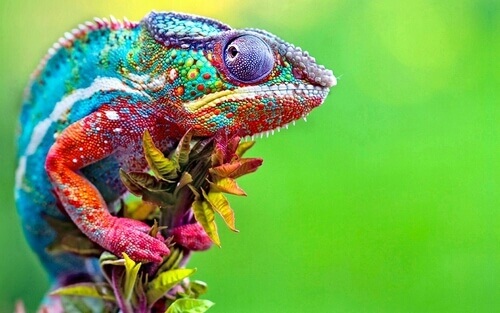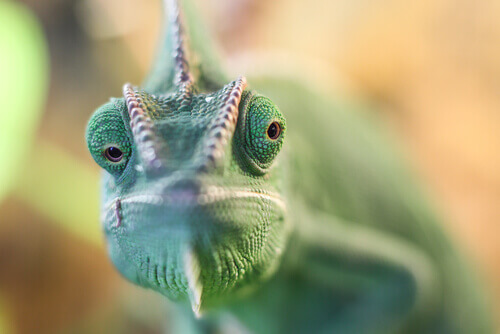How to Identify the Gender of a Chameleon

There’s no sexual dimorphism in a chameleon, and so it’s hard to identify their gender. Both seem the same to the naked eye. Given its popularity as a pet, many people want to know whether theirs is male or female. There are some steps to follow that will help us identify yours. Continue reading to find out more about it.
Identifying the gender of a chameleon
Look at their private parts
There’s nothing characteristically visible that’ll let you discern whether a chameleon is male or female. However, some specimens have a small protuberance in their private parts, which reveals their gender.
It’s right at the base of the tail and is pretty much invisible until they’re several months old. Don’t expect to find it in one that’s still a baby.
Their colors
As a general rule, males tend to have more intense and striking colors than females. This is something that you’ll also notice as an adult. As we said above, this isn’t well developed in baby chameleons yet.
In contrast, females change shades when in heat or when they’re carrying eggs; their colors are more subtle though. Still, they’re often a lot more striking than the males.
Size matters
As with many animal species, male chameleons tend to be larger and more robust than females. Of course, this is easily differentiated if you have two chameleons, but harder when you only have one.
However, while this can be a definitive step in differentiating whether a chameleon is male, there are exceptions. This is because some females could be larger, depending on their species or feeding habits.
Reading about your chameleon can help you identify their gender

Being well-informed won’t only help you take better care of your chameleon but you’ll also know the species-specific traits with which to identify their gender. You need to know the species you have though.
Read about these animals and learn some facts about their personality, care, and any other bit of knowledge that’ll improve your coexistence with them. There are many species of chameleons and knowing which one you have will be quite practical.
Beyond identifying the gender of a chameleon – pet species

There are more than 180 different species of chameleons and some of them are hard to get while others are quite expensive, depending on the area where you live. These are the most common.
Jackson’s
This is one of the most characteristic chameleons due to the horns over their mouth and between their eyes. They’re quite docile and usually friendly. Their natural habitat is in Tanzania and Kenya and people import them to European countries because the population is quite large. So, you’re in luck if you live in Europe and want to have a chameleon, stick with a Jackson.
Meller’s
This is also an African species, from Malawi to be precise. Their bluish-green color, together with the yellow and black rings around their body, is their main characteristic and makes them easily recognizable.
Panther
This is the most common type of chameleon and also the most suitable to have as a pet. This is because it’s highly adaptable to all circumstances and types of climate. As you can imagine, it’s ideal for those who want to adopt a chameleon for the first time and don’t know much about their care. This species has a gentle personality.
You already know how to identify the gender of your chameleon and what the most common species are. What do you think? Will you take the plunge?